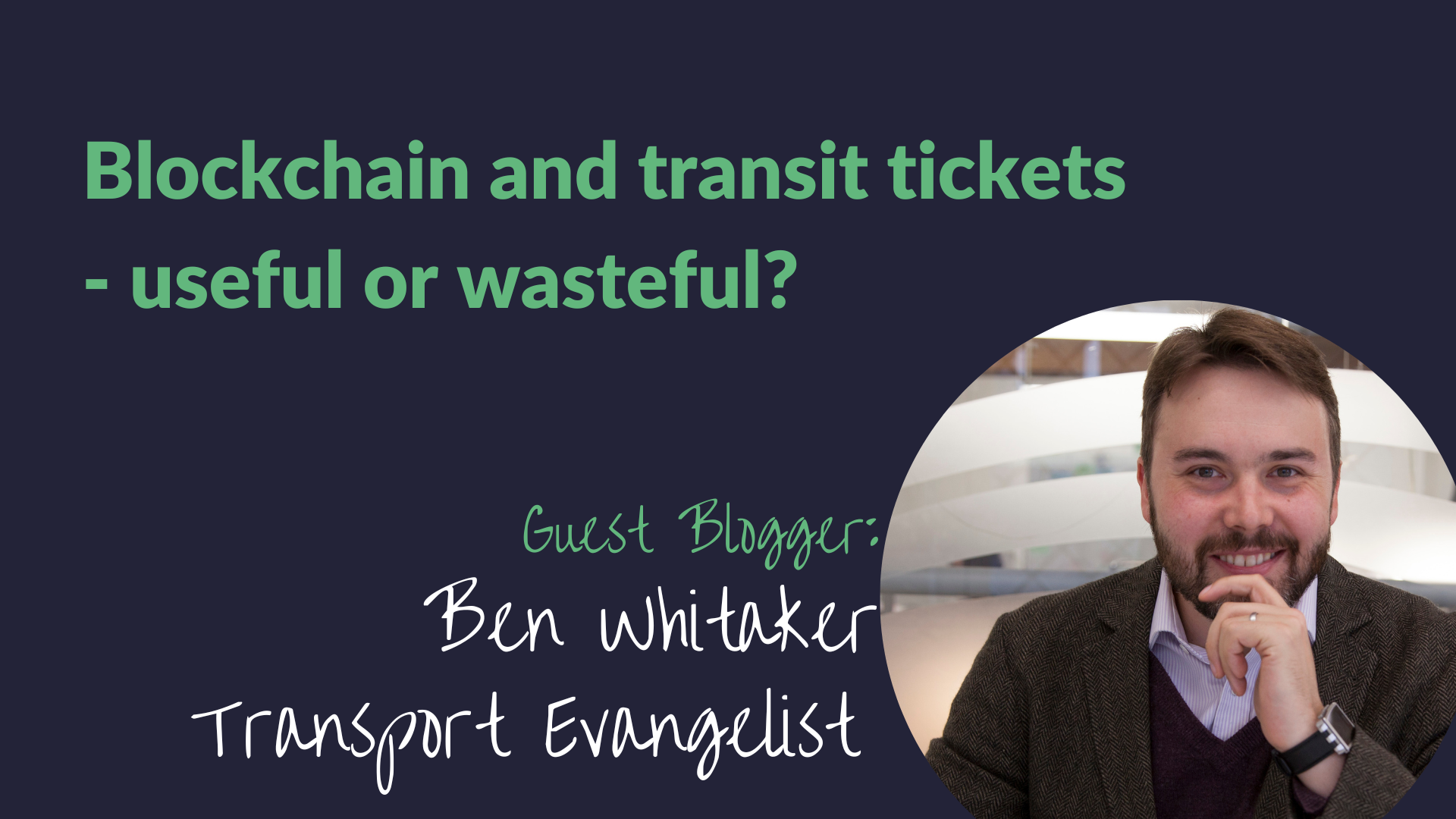Blockchain can be used for more than just cryptocurrency, the underlying technologies can be used to operate shared, distributed, decentralised ledgers (like a data store you can add to but not delete) with resistance to rogue alterations (immutable). Innovation leaders are often asked to investigate new trends and technical buzzwords to see if there are opportunities to improve public transit with these new ideas, so let's look at each usage and see if there are needs within transit ticketing that would be usefully answered by blockchain.
Cryptocurrency for Payments?
Short answer: No - they are far too wasteful, and dangerous for the general public.
Blockchain is one of the key technologies behind cryptocurrencies like Bitcoin. Bitcoin, the most popular cryptocurrency, and other Proof of Work (PoW) cryptocurrencies are criticised because they are by design very wasteful of energy both in the initial token creation, known as “mining” consuming over 128TWhr of power in the previous year (more energy than Pakistan or the Netherlands use in a year), but also transactions (data changes) are very energy intensive to record, reach consensus and distribute to the peers around the world, using 1.5MWh for one bitcoin transaction, the equivalent of 50 days’ of energy use for an average USA home (source: https://digiconomist.net/bitcoin-energy-consumption). Instead of completing one bitcoin transaction, the same energy could power 1 million conventional credit card transactions.
These huge uses of energy would suggest that even if bitcoin were useful for some financial transactions, it would be cost-prohibitive to pay for a small-value transit pass, and also very environmentally destructive, compared to using any other conventional payment option.
What about increasing transit access? Are there demographics that can only use a blockchain-based payment, that cannot access public transit easily without it? Currently users of bitcoin and cryptocurrencies are usually high-technology-using early adopters with access to many other payment options, and bitcoin does not represent a vulnerable minority that requires transit access through this unusual payment method.
Cryptocurrencies are also very complex to access, with plenty of opportunities for the unwary (or even expert) user to be scammed, lose money or even to suffer from the volatility of exchange prices between normal national currencies and cryptocurrencies. Stock markets are volatile too, but are regulated to prevent market manipulation by large players, unlike cryptocurrencies which are unregulated and can legally have prices manipulated by large “whales” that control most of the stock and can alter prices through synthetic high-volume trades between their own accounts (see https://www.pymnts.com/cryptocurrency/2022/in-crypto-market-manipulation-remains-a-problem/ ). Members of the public have lost life savings to cryptocurrency speculation, as well as to fraudulent or hacked cryptocurrency exchanges where they buy and sell cryptocurrency.
Granted some crypto-currencies are moving from the wasteful-by-design “proof of work” approach to the less wasteful “proof of stake” approach, like the recent Ethereum update (see https://www.bbc.co.uk/news/technology-62891715 ), but that doesn’t remove the other negative sides of the unregulated cryptocurrency world.
I would personally say that public transit’s goal to provide an efficient, sustainable, accessible and equitable transportation method are completely opposite to the energy waste and lack of regulation and safety of cryptocurrencies, and until cryptocurrencies solve those issues, public transit should refuse to add any legitimacy or encouragement to its use by the general public, and shouldn’t invest any time or money in cryptocurrency-related activities.
What about CBDC like China’s Digital Yuan or “mobile wallets” like Africa’s mPesa?
Short answer: YES. (but they aren’t normally blockchain)
Central Bank Digital Currency is a blanket term for national bank-issued digital money. Several countries are experimenting with various pilots of digital money for the general public. It should be noted that these CBDC trials are very rarely a blockchain based decentralised system, but like mPesa and China’s current Digital Yuan pilots are centralised, usually operate via barcodes and mobile phones, and don’t have any blockchain technology in them at all - thus avoiding the energy waste issues, and are also completely regulated and tied to the local fiat currency to avoid the fraud, scam and volatility issues.
If there are significant numbers of riders using CBDC in a given area, then a public transit system should probably adopt it as another accepted payment option.
(purist note - mPesa isn’t strictly a CBDC, but looks and acts a lot like it to the consumer, other than it is run by a large mobile network operator rather than a bank, and has higher transaction fees than most CBDC.)
What about non-payment blockchain technology for interoperable ticket infrastructure?
Short answer: Probably no - unnecessary complexity, and too wasteful in data, time and energy compared to simpler solutions.
Digital tickets are straightforward to use within a single transit operator that sells, issues, and validates the tickets, but can become more difficult to manage if there are more than one seller, transit operator and ticket validation entity that need to have a shared view of ticket issuing, use and refunding to prevent fraud as a rider travels between operators and equipment vendors.
There are several projects that seek to use a blockchain to enable digital tickets, stored value account balances and their status to be shared between multiple actors and vendors in a transit setting, and use the blockchain consensus and transaction signing to prevent bad transactions entering the system and provide trust between participants that data once accepted by the peer network are immutable and agreed.
One of the downsides to blockchain is that so much of the entire history needs to be shared and distributed in order for each participant to recreate and check the signed hashes on each transaction or database entry. This is a bandwidth and computationally expensive process that would for a widely used system (say European wide) require a lot of redundant, unnecessary data to be shared and distributed to all participants that all recompute and check the resulting hashes and cryptographic signatures, just so that data consistency can be checked over the few transactions that were interesting to that participant. The data and processing overheads, and corresponding power use, would be quite wasteful.
Blockchain is also quite slow, with current payment blockchains taking between 10 minutes and an hour to complete a transaction - some ABT systems want far lower latency so that when a customer tops up an account, they want to see their updated balance and travel within a minute or two.
However, it comes as a surprise to some that a multi-operator, multi-retailer, multi-vendor, distributed, cryptographically secured, and decentralised digital ticketing system has been operating for years in the UK rail network without requiring any blockchain technology at all.
Even more surprising is discovering that this is now the most popular ticket format, responsible for more tickets than any other technology in use in the UK railways today.
That system is the barcode ticket standard, created by Masabi and RSP/ATOC in 2008.
Encapsulated in standards documents RSPS1024 (code of practice), RSPS3001 (ticket encryption and data formats), RSPS3013 (ticket visual layout), RSPS5043 (data sharing between participant retailers, operators and validators) they provide for a system that uses asymmetric encryption for each approved retailer’s private key to sign tickets that they issue and have taken payment for, all operators can download freely the public keys for all issuers so that they can check the tickets, SSL server signatures to prevent bad actors from adding data to the system, and making sure any changes inserted are attributed to the authenticated actor that added them, subscription lists to ensure only relevant data is synchronised to each actor, and decentralised databases operated by each participant to give each participant control over their own data and resilience, and no dependency on a central database of any sort. The only centralised asset is a static XML file listing the participant server URL’s, their subscriptions and public keys that can be checked occasionally by participants to determine which other servers need to be contacted to download relevant records, and also which actors have signed up to the code of practice and are permitted. This allows participants to know whether tickets have been used before refunding, or if someone has tried to refund them then use them.
There are also shared standards for multi-operator encrypted digital tickets around the world for airline tickets from IATA, and spanning European long-distance rail from UIC, and in several countries for all public transit, such as Germany’s eVDV, without any of these needing blockchain either.
Basically, it is possible to achieve the requirements of interoperability without requiring the overheads of blockchain in this space, as in all of these cases there is a clear regulator and commercial trust framework to rely on, and no reason or benefit of deferring the trust out to a more amorphous consensus group. Even if you were using a blockchain in public transit ticketing, you would still need to operate some form of oversight and gatekeeping of actors into the network to prevent abuse - simply saying “blockchain” does not remove that.
For more on this topic and many others related to innovation in transit, subscribe to my Transit Voices Podcast. Fresh new episodes are published every month.
Here is the discussion I had with David Leininger about blockchain in transit, while Simon Laker and I are talking about CBDCs in the latest episode of the podcast.


